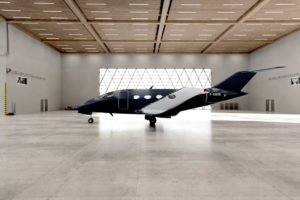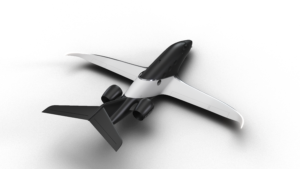French startup Beyond Aero revealed the design for its hydrogen fuel-cell powered business jet to the world for the first time at the International Paris Air Show earlier this year.
Beyond Aero, which is headed up by CEO and co-founder Eloa Guillotin plans to have certified the all-electric BYA-1 business jet under EASA CS-23 regulations by the end of the decade. If this timeline is achieved, the BYA-1 would be the world’s first hydrogen fuel cell business jet.
The development of the BYA-1 jet comes at a time when private aviation is coming under increasing pressure about its high carbon emissions. Widely seen as the preserve of the rich and famous, business jet passengers have massive carbon footprints compared to commercial aviation.
The BYA-1 is designed to seat up to eight passengers and to have a range of 1,500km (930 miles), with a cruise speed of 573 km/h (356mph). It will be capable of operating from 2,800ft runways. According to the company it has signed letters of intent for 72 aircraft, with a value of US$580 million.
The aircraft’s design features a half-moon-shaped air inlet at the rear to cool the powertrain, a system patented by Beyond Aero. Another patent covers the concept for positioning the fuel tanks in a fairing under the fuselage to avoid compromising space in the cabin.
The hydrogen fuel cell system will power two 500kW electric ducted fans. The company plans for the aircraft’s propulsion system to first use gaseous hydrogen and later be converted to pressurized liquid hydrogen.
Beyond Aero, which was founded in 2020 has so far produced and tested an 85kW scale propulsion system at its site located at Toulouse-Francazal Airport. The low-temperature proton exchange membrane fuel cell will work in tandem with a battery system. The batteries will boost power during take-off and as a backup.
The propulsion system is being integrated and flown on a G1 Aviation two-seater ultralight aircraft to address technological challenges related to hydrogen, optimize weight and to address integration constraints. The team will then develop a 1MW propulsion system that places the two electric-powered ducted fans on the rear of
the fuselage.
Aerospace Testing International talked to Guillotin, one of three co-founders of the company shortly after the Paris Air Show. She believes passionately that aviation will inevitably become electric and that it is her job to ensure it happens.
Can you describe your current role?
As the co-founder and CEO of Beyond Aero, my responsibilities revolve around three main pillars. Firstly, I deal with clients, including sales and customer interactions. Secondly, I handle human resources, which involves recruitment and fostering a positive company culture.
Lastly, I oversee financial management. In essence, my time is divided among working with the team, catering to the needs of our clients and navigating the aviation industry.
How did you come up with the Beyond Aero concept?
 The idea for Beyond Aero originated during my aerospace engineering studies at École Polytechnique and HEC Paris, where I met my co-founders, Hugo Tarlé and Valentin Chomel. Together, we started to explore emerging technologies, particularly electric models and the certification of electric aircraft.
The idea for Beyond Aero originated during my aerospace engineering studies at École Polytechnique and HEC Paris, where I met my co-founders, Hugo Tarlé and Valentin Chomel. Together, we started to explore emerging technologies, particularly electric models and the certification of electric aircraft.
As we delved into questions about the feasibility and sustainability of electric aircraft, we sensed there was a pivot happening in the industry. We became convinced that aviation would eventually shift towards electric propulsion, and we sought to determine the right market entry point and the first movers.
Our initial focus was on implementing electric propulsion for aircraft and identifying the appropriate aircraft size through client consultations and certification pathway studies. As a result, we embarked on the journey to create a company that addresses the critical need to decarbonize aviation.
What do you hope Beyond Aero’s impact on private aviation will be?
Beyond Aero’s vision goes beyond merely influencing the private aviation sector, we aspire to revolutionize the entire aviation industry.
Starting with a premium product allows us to navigate the certification process more smoothly. While existing electrical engine and fuel cell technologies are viable for smaller aircraft, we fully recognize that the challenge for the industry lies in scaling up electrical technology for
larger aircraft.
Our ultimate goal is to lead the industry towards decarbonization, without aiming to outpace existing suppliers. Instead, we want to demonstrate that technology can be harnessed to reduce the environmental impact and improve the sustainability of aviation. To achieve this, collaboration among stakeholders is vital.
Can you describe the design of the BYA-1?
 The BYA-1 stands out as an electric aircraft, with two engines powered by fuel cells running on gaseous hydrogen. Our decision to use gaseous rather than liquid hydrogen simplifies the technology and will aid certification.
The BYA-1 stands out as an electric aircraft, with two engines powered by fuel cells running on gaseous hydrogen. Our decision to use gaseous rather than liquid hydrogen simplifies the technology and will aid certification.
Developing the aircraft required addressing several challenges, such as determining the tanks’ volume and weight, managing the heat from the fuel cells, and optimizing the air intake.
Despite these complexities, we aim to retain a conventional aircraft design to streamline the certification process and make it more appealing to potential private aviation customers. The aircraft’s distinctive features, such as the half moon shape and structural beam protecting the tanks in the middle of the aircraft reflect our commitment to striking the right balance between innovation and adherence to established aviation norms.
What are the short term goals for the company?
In the short term our primary focus is on continuing to improve the prototype and designing the aircraft. We are committed to ensuring that the design is both safe and realistic, which entails meticulous supplier selection and ongoing testing.
Do you have a final date you can share for the aircraft’s certification?
While we have set a target, I prefer not to disclose it as the aircraft development project is continuously evolving. Our current aim is to have the aircraft ready before 2030, and we are diligently working towards achieving that goal.
What is your attitude towards innovation and failure?
To me, failure occurs when we fall short of reaching our objectives. Setting clear and achievable goals is crucial, and I break down the long term vision into short term milestones. This approach allows us to measure success and progress continually.
While innovation is at the core of our mission, we must also remain pragmatic and ensure that our innovations are certifiable and valuable to the aviation industry.
What do you see as the main technical challenges for the aircraft?
 Although the technology we have chosen exists in other domains like trucks, cars, and boats, the real challenge lies in making it viable and certifiable for aircraft. We must address specific intricacies and limitations unique to aviation.
Although the technology we have chosen exists in other domains like trucks, cars, and boats, the real challenge lies in making it viable and certifiable for aircraft. We must address specific intricacies and limitations unique to aviation.
What did the recent testing of the propulsion system involve?
In recent testing, we achieved the mission profile of 85kW, utilizing the same architecture we intend to use for larger aircraft. Although we encountered challenges, the successful testing indicates progress towards our goal. The testing campaign remains ongoing, allowing us to learn and improve continuously.
What are the long-term milestones?
Our ultimate long term milestone is to certify the aircraft. However, we also recognize the importance of expanding our team, securing additional capital, and establishing strategic partnerships with suppliers.
What advice would you give to someone who wants to launch a startup?
My advice to aspiring entrepreneurs is not be deterred by those who say that something is not possible. Set achievable short term goals that align with your long term vision, and strive to make your dreams a reality.
Remember that dreaming big is essential, but grounding those dreams in achievable steps is equally critical to long term success.





